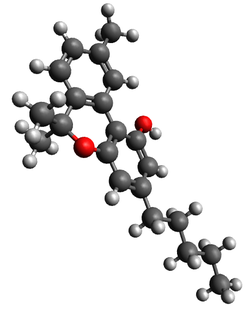| Full Name | Known Receptor Targets | Putative Therapeutic Properties |
|---|
| Cannabichromene (CBC) | - Agonist at CB2, [15] TRPV3, and most potent phytocannabinoid at TRPA1 [15] [13]
- Very low efficacy at TRPV1 and TRPV4, but may reduce expression of TRPV4 in the presence of inflammation [13]
- High affinity for CB1 but no observed functional activity [15]
- Antagonist at TRPM8 [13]
| - Antimicrobial and anti-inflammatory [15]
- Potential neuroprotective effects [15]
- Potential efficacy in treatment of inflammatory pain [15]
|
| Cannabidiol (CBD) | - Very weak affinity for CB1 and CB2 [16]
- Conflicting reports but generally described as negative allosteric modulator at CB1 & CB2, altering THC activity when THC & CBD are coadministered [16]
- Agonist at TRPA1, [13] TRPV1 (high potency at this “capsaicin receptor” without ablative effects [13] ), TRPV2, TRPV3, PPARγ, 5-HT1A, A2 and A1 adenosine receptors [16]
- Highest potency at TRPV1 [13]
- Antagonist at GPR55, GPR18, 5-HT3A, [16] with highest potency as antagonist at TRPM8 [13]
- Inverse agonist at GPR3, GPR6, and GPR12 [16]
| - Anti-inflammatory [17] [13]
- Anti-convulsant [17]
- Potential efficacy in treatment of inflammatory and chronic pain [13]
|
| Cannabigerol (CBG) | - Low affinity agonist and partial agonist at CB1 and CB2, respectively [15]
- Agonist at α2adrenoceptor [15] and TRP channels such as TRPA1, TRPV2, and TRPV3, with highest potency as agonist at TRPV1 [13]
- Readily desensitizes but low affinity for TRPV4 [13]
- Antagonist at 5-HT1A [15] and TRPM8 [13]
| - Anti-microbial, anti-inflammatory, and anti-nociceptive effects [15]
- Neuroprotective properties via mitigation of oxidative stress [15]
- Potential anti-tumor agent [15]
- Potential efficacy in treatment of chemotherapy-induced muscle atrophy and weight loss [15]
|
| Cannabinol (CBN) | - Agonist at CB1 and CB2, with some evidence of slightly higher affinity at CB2 [15]
- Low affinity agonist at TRPV1, TRPV2, TRPV3, TRPV4, and TRPA1, [13] but readily desensitizes TRPV4 [13]
- Antagonist at TRPM8 [13]
| - Antimicrobial and anti-inflammatory / immunosuppressive effects [15]
- Potential efficacy in treatment of ocular disease and epidermolysis bullosa [15]
- Reported neuroprotective effects (synergistic if coadministered with other cannabinoids) [15]
- Relevance to pain, itch, and inflammation via TRP channel activity [15]
|
| Tetrahydrocannabinol (THC) / Delta-9-Tetrahydrocannabinol (Δ9-THC) | - Agonist at CB1 and CB2, as well as GPR55, GPR18, PPARγ, and TRPA1 [13] [16]
- Antagonist at TRPM8 [13] [16] and 5-HT3A [16]
- Differing activity across TRP channels: highest potency phytocannabinoid at TRPV2; modest activity at TRPV3, TRPV4, TRPA1, and TRPM8; no activity observed at TRPV1 [13]
- Importantly, 11-OH-THC, the active metabolite generated via first-pass-metabolism of THC, demonstrates different binding profile at TRP channels [13]
| - Potential relevance to sleep induction (e.g., increased adenosine levels [16] ) and increased quality of sleep [13]
- Dose-dependent anxiolytic effects, [13] with anxiogenic effects at high doses
- Appetite stimulation [13] [14]
- Anti-nausea [13] [14]
- In combination with CBD, potential efficacy in treatment of spasticity, neuropathic pain and muscle spasticity (see Sativex: THC-containing therapeutic approved in Europe as treatment for Multiple Sclerosis)
|
| 2-Arachidonoylglycerol (2-AG) | - Partial agonist at CB1 (e.g., on lysosomal surface, increasing lysosomal integrity) and CB2 [16]
- Agonist at GPR55, GPR18, GPR119, PPAR, and robust activation at TRPV4 [13] [16]
| - Anti-oxidative properties [16]
- Increased lysosomal stability & integrity [16]
- Attenuation of mitochondrial damage during cell stress [16]
|
| Anandamide (AEA) | - Agonist at GPR18, GPR119, and PPAR, with robust activation at TRPV4, and very high efficacy at TRPA1 [13] [16]
- Potent partial agonist at GPR55 [16] [14]
- Low-affinity full agonist at TRPV1, [13] [14] with similar but less potent affinity as compared to capsaicin [13]
- Antagonist at TRPM8 [13]
| Anti-oxidative properties [16] |




